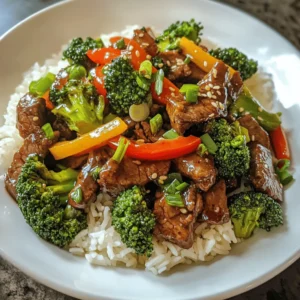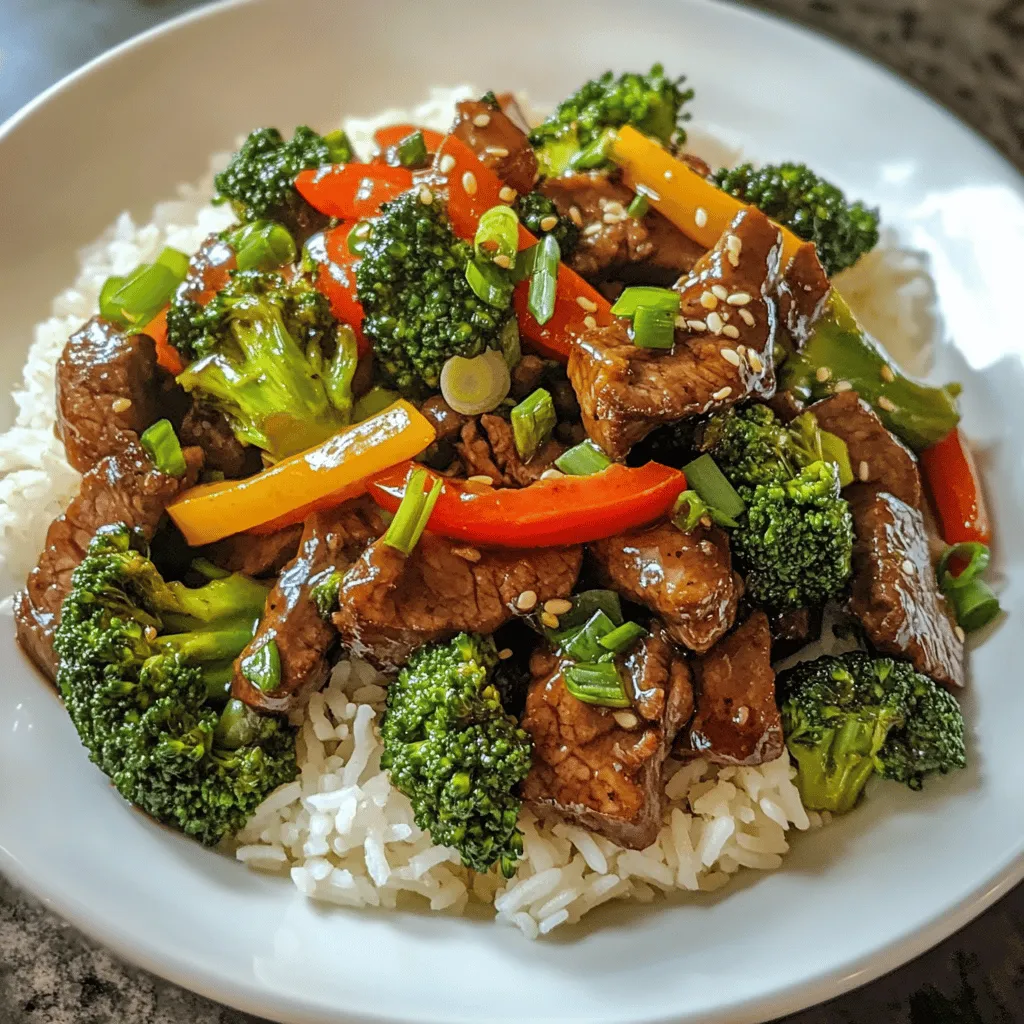Introduction
Chinese cuisine has captivated the taste buds of people around the world, becoming a beloved staple in many households. With its vibrant flavors, diverse ingredients, and rich culinary traditions, it’s no wonder that dishes like Chinese Beef and Broccoli Delight have made their mark on the global food scene. This dish, a classic in Chinese-American cooking, exemplifies the harmony of flavors that define this cuisine. It combines tender beef with crisp broccoli, all enveloped in a savory sauce that brings out the best in each ingredient.
Chinese Beef and Broccoli Delight is not just a feast for the senses; it also offers a wealth of health benefits. Featuring lean protein from the flank steak and a variety of vitamins and minerals from the broccoli, this dish stands out as an excellent choice for those seeking a nutritious meal. The vibrant color of fresh vegetables not only enhances the dish visually but also contributes to a balanced diet. This article will guide you through the preparation of this flavorful dish, exploring its ingredients, techniques, and the steps to achieve perfection in your own kitchen.
Understanding the Ingredients
Flank Steak: A Deep Dive into the Cut
At the heart of this recipe is flank steak, a cut of beef that is not only affordable but also packed with flavor. Flank steak comes from the abdominal muscles of the cow, making it a lean cut with a rich, beefy taste. This cut is particularly popular in stir-fries due to its ability to absorb marinades and its tendency to become tender when cooked correctly.
One crucial tip when working with flank steak is to slice it against the grain. This technique involves cutting the meat perpendicular to the direction of the muscle fibers, which helps break down the tough fibers and results in a more tender bite. When prepared correctly, flank steak can be incredibly juicy and satisfying, making it the perfect protein base for our Beef and Broccoli Delight.
The Role of Sauces in Flavor Development
Sauces play a pivotal role in Chinese cuisine, and in this dish, they are essential for elevating the overall flavor profile. Soy sauce is the backbone of many Asian dishes, contributing a deep umami flavor that enhances the savory notes of the beef. It also acts as a marinade, infusing the meat with moisture and flavor.
Another key ingredient is oyster sauce, which adds a unique sweet-savory balance to the dish. Made from oyster extracts, this sauce provides depth and richness, making it a favorite among chefs and home cooks alike. Additionally, cornstarch is used in this recipe to thicken the sauce, creating a velvety texture that clings to the beef and broccoli beautifully.
Broccoli and Bell Peppers: Nutritional Powerhouses
Broccoli is more than just a colorful addition to this dish; it is a nutrient-dense vegetable packed with vitamins and minerals. Rich in vitamin C, vitamin K, and fiber, broccoli supports overall health and digestion. It also contains antioxidants, which can help protect the body against various diseases.
Incorporating colorful bell peppers not only enhances the visual appeal of the dish but also boosts its nutritional value. Bell peppers are an excellent source of vitamin A and vitamin C, and their vibrant colors signal a variety of beneficial compounds. The combination of broccoli and bell peppers contributes essential nutrients while adding a satisfying crunch that complements the tender beef.
Aromatics: The Heart of Flavor
No Chinese dish is complete without aromatics, and in this recipe, garlic and ginger take center stage. These ingredients are essential for building flavor, as they release their oils and compounds when sautéed, infusing the dish with an irresistible aroma. Garlic adds a pungent, savory note, while ginger contributes warmth and a hint of spice. Together, they create a fragrant base that enhances the overall taste and elevates the dish to new heights.
The Importance of Sesame Oil and Rice Vinegar
Finally, we cannot overlook the significance of sesame oil and rice vinegar in this recipe. Sesame oil, with its nutty flavor and rich aroma, adds depth to the dish, making it even more flavorful. A drizzle of sesame oil at the end of cooking can elevate the taste, providing a finishing touch that ties all the elements together.
Rice vinegar, on the other hand, offers a bright and tangy flavor that balances the richness of the beef and sauce. It helps to cut through the fat and adds a refreshing note that enhances the overall experience of the dish. Together, these ingredients create a complex flavor profile that is both satisfying and delicious.
Preparation Steps Explained
Marinating the Beef: Importance and Techniques
The first step in preparing Chinese Beef and Broccoli Delight is marinating the flank steak. Marination is a vital process that not only infuses the meat with flavor but also helps tenderize it. The marinade typically includes soy sauce, oyster sauce, and a touch of cornstarch. This combination allows the meat to soak up the savory flavors while the cornstarch helps create a smooth texture that enhances the sauce.
To marinate the beef effectively, start by slicing the flank steak into thin strips, about 1/4 inch thick. This thinness ensures that the meat absorbs the marinade quickly and cooks evenly. In a mixing bowl, combine the sliced beef with the marinade ingredients, making sure to coat every piece thoroughly. For best results, let the beef marinate for at least 30 minutes, though longer marination (up to a few hours) can yield even more flavorful results.
Tips for Effective Marinating
When marinating, keep a few tips in mind to achieve optimal flavor and tenderness:
1. Use a Resealable Bag: For even coating, consider placing the beef and marinade in a resealable plastic bag. This method allows for better distribution of flavors and minimizes cleanup.
2. Avoid Over-marinating: While marination is essential, too long can lead to a mushy texture. Aim for a balance—30 minutes to 2 hours is generally ideal.
3. Refrigerate While Marinating: Always marinate your beef in the refrigerator to prevent bacterial growth and ensure the meat stays fresh.
The Perfect Searing Technique
Once your beef has marinated and is ready to go, it’s time to sear it to perfection. Searing is a cooking technique that involves cooking meat quickly at high heat to create a flavorful crust while sealing in the juices. This method is crucial for achieving that restaurant-quality texture and taste in your Beef and Broccoli Delight.
To sear the beef, heat a wok or large skillet over high heat. Add a tablespoon of oil with a high smoke point, such as vegetable oil or peanut oil. Once the oil is shimmering, add the marinated beef in a single layer, ensuring not to overcrowd the pan. This allows for proper browning and caramelization. Sear the beef for about 1-2 minutes on each side until it is browned but not fully cooked through. This quick cooking time locks in the juices and prevents the meat from becoming tough.
After searing, remove the beef from the pan and set it aside. This step is essential before adding the vegetables, as it prevents overcooking and allows you to control the doneness of the beef when combined with the broccoli and sauce later on.
As you prepare to continue with the cooking process, remember that the key to a successful Chinese Beef and Broccoli Delight lies in the balance of flavors, the quality of ingredients, and the techniques employed throughout the preparation. With the beef marinated, seared, and ready, you are well on your way to creating a delicious and satisfying meal that will impress family and friends alike.

Importance of Cooking in Batches for Even Browning
When preparing Chinese Beef and Broccoli Delight, one of the key techniques to master is cooking in batches. This method is essential for achieving that beautiful, succulent browning on the beef that elevates the dish’s overall flavor and texture. Cooking too much beef at once can lead to overcrowding in the pan, resulting in steaming rather than searing. For optimal results, cook the beef in two or three smaller batches, allowing each piece to come into direct contact with the hot surface of the pan. This ensures each piece gets that perfect caramelization, enhancing the Maillard reaction—a chemical process that occurs when proteins and sugars in food react under heat, creating rich flavors and aromas.
Explanation of the Maillard Reaction in Searing Meat
The Maillard reaction is a fundamental cooking process that occurs when proteins and sugars undergo a series of complex reactions during cooking, typically at high temperatures. This reaction not only contributes to the attractive brown color of the beef but also enhances its flavor profile, adding depth and complexity that is essential in Chinese cuisine. To achieve the Maillard reaction, ensure your pan is adequately preheated before adding the beef. A hot pan allows for quick browning, minimizing moisture loss and ensuring the meat remains juicy and tender. Remember, the right temperature is crucial; too low, and you’ll end up steaming the meat instead of searing it.
Stir-Frying Vegetables to Perfection
Vegetables are just as important as the beef in this dish, providing essential nutrients and a vibrant array of colors. Broccoli, in particular, is a star ingredient, adding a satisfying crunch and earthy flavor. To achieve the ideal texture in stir-fried vegetables, consider the following techniques:
– Cut Uniformly: Ensure all vegetables are cut into similar sizes to promote even cooking. This allows for consistent texture and helps avoid some pieces being overcooked while others remain underdone.
– Use High Heat: Stir-frying requires high heat to quickly cook the vegetables while maintaining their crispness. A wok or a large skillet works best for this purpose, allowing for ample surface area and even heat distribution.
– Add in Stages: When stir-frying, add vegetables in stages based on their cooking times. For instance, broccoli florets take longer to cook than bell peppers, so add them to the pan first. This method ensures that all vegetables are cooked perfectly and retain their vibrant colors and nutritional value.
Timing for Adding Aromatics to Maximize Flavor
Aromatics such as garlic and ginger play a pivotal role in developing the dish’s flavor profile. Timing is crucial when adding these ingredients; they should be introduced after the vegetables have begun to soften. Adding aromatics too early can result in burnt flavors, which can overpower the dish. Aim to add minced garlic and ginger to the pan just after the broccoli has started to turn bright green and tender but before it is fully cooked. This timing allows the aromatics to infuse their flavors into the vegetables and beef without losing their freshness.
Combining Ingredients for the Final Dish
Combining the cooked beef and vegetables is the last step in creating your Chinese Beef and Broccoli Delight. To ensure all components are well-integrated and heated through, consider the following tips:
– Use the Right Sauce: The right sauce can pull the entire dish together. A well-balanced sauce made from soy sauce, oyster sauce, and a hint of sesame oil can enhance the flavors of both the beef and broccoli.
– Toss Gently: Once you’ve added the beef back to the pan with the vegetables, use a spatula or tongs to gently toss everything together. This method prevents any ingredients from breaking apart and ensures that the sauce coats everything evenly.
– Adjust Flavors: Tasting during the cooking process is essential. If you find that the dish needs more salt or sweetness, feel free to adjust the seasoning according to your preference. A splash of soy sauce or a pinch of sugar can make a world of difference.
Serving Suggestions
Presentation Tips for an Appealing Plate
A visually appealing plate can make your Chinese Beef and Broccoli Delight even more enticing. Here are some presentation tips:
– Use a Large Shallow Bowl: A large shallow bowl allows for a generous arrangement of the beef and broccoli, showcasing the vibrant colors of the dish.
– Layer Neatly: Start with a base of jasmine rice, then artfully arrange the beef and broccoli on top, ensuring the colors and textures are visible.
– Add Colorful Garnishes: Fresh garnishes can elevate the visual appeal. A sprinkle of sesame seeds or finely chopped green onions adds color and a fresh element to the dish.
Ideas for Garnishing with Chopped Green Onions
Chopped green onions are a classic garnish for this dish. They add a fresh crunch and a pop of color. Scatter them generously over the top just before serving. For an even more appealing presentation, consider slicing some green onions into long ribbons and curling them in ice water for a few minutes before placing them on the dish. This technique adds an elegant touch.
Suggestions for Plate Arrangement to Enhance Visual Appeal
When arranging your dish, consider using the rule of thirds to create balance. Place the beef and broccoli on one side of the plate and the jasmine rice on the other, leaving some space for garnishes. This arrangement draws the eye and creates a more inviting presentation.
Pairing Options for a Complete Meal
To create a well-rounded meal, consider pairing your Chinese Beef and Broccoli Delight with complementary side dishes. Here are some recommendations:
– Jasmine Rice: This fragrant rice is a traditional accompaniment, perfect for soaking up the savory sauce.
– Spring Rolls: Crispy vegetable or shrimp spring rolls add a delightful crunch and are a popular starter in Chinese cuisine.
– Wonton Soup: A light and flavorful wonton soup can serve as a wonderful appetizer, setting the stage for the main event.
– Beverage Pairings: A chilled jasmine tea or a light Chinese beer can enhance the dining experience, balancing the dish’s flavors.
Cultural Significance of Beef and Broccoli
The Dish’s Evolution in Chinese-American Cuisine
Chinese Beef and Broccoli has become a staple in Chinese-American cuisine, often enjoyed by those seeking a comforting yet flavorful meal. This dish exemplifies how traditional Chinese recipes have evolved in a Western context, adapting to local tastes while maintaining a semblance of authenticity.
Historical Context of How the Dish Became Popular in the U.S.
The origins of Beef and Broccoli can be traced back to the Chinese immigrants who settled in the United States during the 19th century. As they introduced their culinary traditions, adaptations began to emerge. Beef and broccoli, featuring easily accessible ingredients, quickly gained popularity in Chinese restaurants across the country, becoming synonymous with takeout culture.
Reflection on Cultural Adaptations and Authenticity in Recipes
While the dish may not be found in traditional Chinese cuisine in its current form, it represents the fusion of cultures. The balance of flavors, textures, and techniques reflects the culinary principles of both Chinese and American cooking. This adaptation allows for creativity and innovation while still honoring the roots of the dish.
Exploring Variations Across Different Regions
Chinese Beef and Broccoli is just one interpretation of the myriad ways beef and vegetables are prepared throughout various regions in China. Each area brings its unique flavors and techniques, resulting in a diverse array of stir-fried dishes. For example:
– Mongolian Beef: This dish typically features sliced beef in a sweet and savory sauce, often accompanied by scallions and served over rice.
– Szechuan Beef: Known for its bold flavors and spicy elements, Szechuan beef often includes a variety of peppers and a kick of heat.
Discussion on Dietary Adaptations (Vegan Options, Gluten-Free Alternatives)
As food preferences evolve, so do recipes. For those seeking vegan options, consider substituting the beef with tofu or seitan, which can absorb the flavors of the sauce beautifully. Additionally, for gluten-free variations, tamari can replace soy sauce, ensuring that those with dietary restrictions can still enjoy a delicious meal.
Conclusion
Chinese Beef and Broccoli Delight is a beloved dish that combines tender beef and vibrant broccoli in a savory sauce, creating a satisfying meal that appeals to many palates. The careful techniques of searing, stir-frying, and combining ingredients all contribute to the dish’s rich flavor profile and appealing texture.
By preparing this recipe at home, you not only get to enjoy a taste of authentic Chinese flavors but also have the opportunity to share a meal that reflects cultural appreciation. Cooking is a joyful experience that brings people together, allowing for shared moments around the dinner table. Embrace the art of cooking and the beauty of sharing meals with loved ones—your culinary journey starts with this delightful dish.



